From the Field: Bill Buck in Cape Horn, Day 10
Posted in Bill Buck, From the Field, Science on February 14 2012, by William R. Buck
January 29, 2012; Canal O’Brien, on the way to the Brazo Noroeste of the Beagle Channel, approximately 54º55’S, 70º35’W
The day and a half in Punta Arenas flew by. Upon arriving, our luggage was taken to the hotel while we went to the Universidad de Magallanes where we have left our collections to dry completely while we are on the second half our trip. The humidity in Punta Arenas is so low that all we have to do to is leave all the plant materials spread out in a warm room. The whole next day was spent doing chores, depending on need. Some went shopping, I worked on keying my blog into a laptop, and others were simply tourists. That evening we had a final dinner, in part to say goodbye to Ricardo and Mauricio, but also to see some Spaniards who were in transit to and from Antarctica (including bryologist Francisco “Paco” Lara).
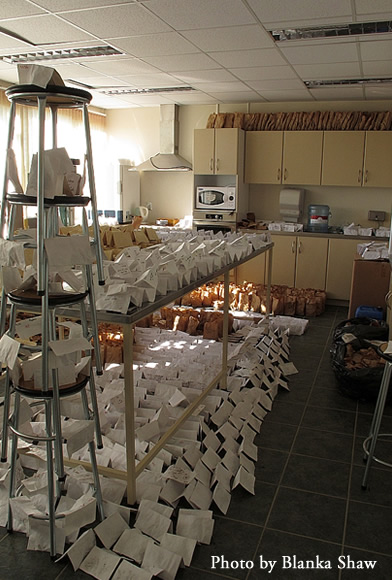
We had hoped to get an early start the next morning, but of course we didn’t. We finally left the dock at around 2:30 p.m. The weather was glorious and the seas calm; patches of blue sky showed through the clouds and the sun shone brightly on the glacier-capped Monte Sarmiento. With such surprisingly good weather, our spirits were running very high.
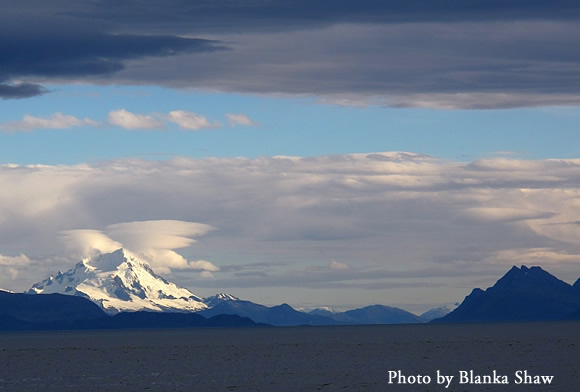
When I came out onto the deck this morning the sky was overcast and a light rain was falling. However, as we proceeded on our course to the eastern end of the northwest arm of the Beagle Channel, blue skies seemed to be following us, and as I watched, the blue skies began gaining on us and now they have caught up with us; the day shows great promise.
My writing was just interrupted by a whale sighting. It breached several times, but almost of more interest was the reaction of our group. Some immediately ran to look and were satisfied with simply experiencing the moment, while others ran for their cameras and missed the whale entirely. Surely there’s a lesson here about living in the moment, and I hope to find a way to apply this to moss collecting.
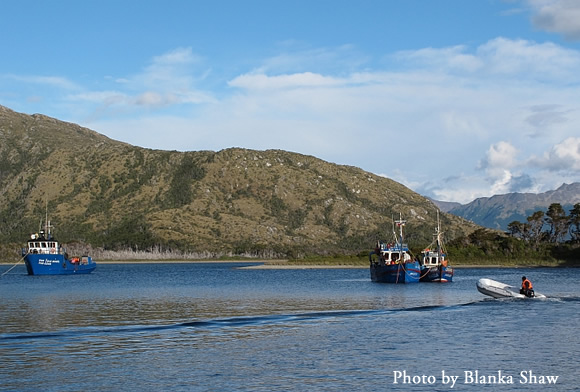
Our destination is Caleta Olla, a harbor on Isla Grande de Tierra del Fuego near the eastern end of Isla Gordon, not far from where we began collecting on the first part of the trip. I have visited this site previously; it is primarily a vast peatland. It will be a new habitat for this trip and a nice start to the second half. However, it will take most of today to reach there and so we will have to wait until tomorrow for the fun to begin.
January 29, 2012; Isla Gordon, Bahía Romanche, approximately 54º57’S, 69º30’W
I was sitting on the bow of the ship as we proceeded up the northwest arm of the Beagle Channel. The landscape is stunning, almost literally–I stared in awe as time seemed to stand still. It took a while before my mind started working again. It reminded me of a similar situation, long ago and far away. It was 1979 and I was sitting on the bow of a ship going up the Rio Negro in Amazonian Brazil. I was alternately admiring/enjoying the lush tropical forest and reading Joseph Conrad’s Heart of Darkness. It was a transformational experience as I suddenly felt that I finally, truly understood the habitat in which the book is set.
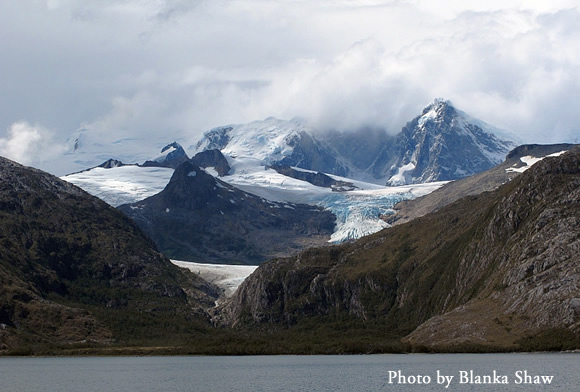
Today was much the same but I was glad to not be distracted by a book. It is one day in a hundred. In the half dozen times I have visited this region this is only the second time that I can remember scenery this beautiful combined with weather this pleasant, and that last time was much less scenic! The sky is bright blue with fluffy white clouds on the horizon and it actually feels warm sitting on the bow. However, this is more of an illusion than reality. The sun is, at best, a fleeting, fair weather friend in this area, but it still made it seem deceptively warm–only a few feet away, in the shade of the ship’s bridge, it feels cold and the breeze which felt refreshing in the sun, now feels icy.
However short-lived, the bright sun highlights the jaw-dropping scenery. The sides of the channel consist of a rugged landscape of craggy peaks and deep ravines, each ravine bejeweled with a waterfall more impressive than the last. The relatively sun-warmed, north-facing slopes of Isla Gordon are often bare at the summit except for sheltered pockets of late snow. The north shore’s south-facing slopes are crusted with one glacier after another. The teal-blue color of the ice is a remarkable contrast to the deep green of the southern beech forests. The frontiers between the two are often outlined by crashing glacial melt-fed whitewater falls. Here, like elsewhere in the world, glaciers are retreating, and the pleasure of a sunny day is diminished by the thought that the day’s warmth is hastening their demise. For now, though, the sheer beauty of the landscape is almost overwhelming. As far as the eye can see, the Beagle Channel is peak-lined and remains a constant delight.
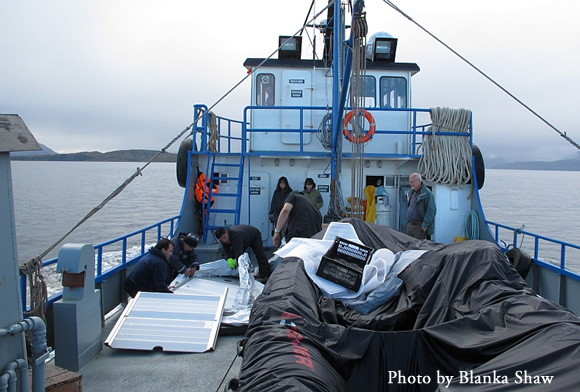
While I was musing on all this glorious beauty, our ship suddenly turned into a large bay on the north shore of Isla Gordon. I didn’t understand why, but soon learned that we needed to take on water. This waterway is well known to the crew and they have favorite spots for filling the water tanks. As we entered the bay we began looking for good collecting sites for the upcoming days. We have finally reached a very sheltered harbor with a steeply cascading waterfall where the boat can be tied directly next to the shore. Of course, Juan and Blanka, closely followed by Lily and Xiaolan, see this as an ideal opportunity to collect a few extra specimens; they simply step off the ship, directly onto the steep slope, and scramble up the heavily vegetated rock, grabbing whatever mosses and liverworts they can find.
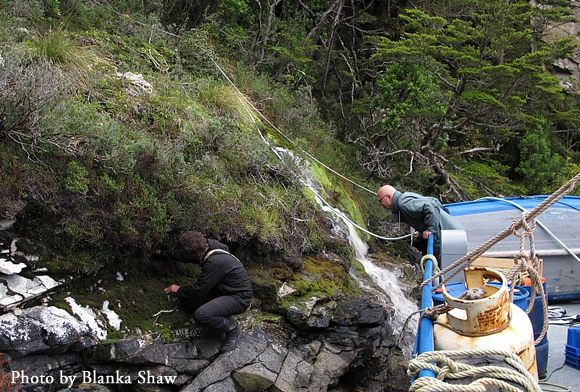
What we should have known, though, was that such activity would anger the weather gods, and almost immediately conditions worsened. Apparently travel in good weather is permitted, but not collecting! Before we were even able to leave the small harbor it began raining, and as we moved out into the open bay we were even pelted by a brief bout of sleet. If this isn’t a sign not to get my hopes up for fair-weather collecting, I don’t know what is. We’re now proceeding to our anchorage for the night, Caleta Olla.
Ed. note: NYBG scientist and Mary Flagler Cary Curator of Botany, Bill Buck is currently on expedition to the islands off Cape Horn, the southernmost point in South America, to study mosses and lichens. Follow his journeys on Plant Talk.
Bill Buck’s Previous Reports From the Field:
2012
January 25, 2012; Isla Darwin, Caleta Virginia, approximately 54º57’S, 70º10’W
January 23, 2012; Arm of Estero Webb, SW coast of Isla Hoste, approximately 55º14’S, 69º41’W
January 22, 2012.; Unnamed sound on Isla Gordon behind Cabo El Gorro, approximately 55º02’S, 69º48’W
January 21, 2012; Isla Hoste, Estero Fouque, 55º1’S, 69º35’W
January 20, 2012; Isla Hoste, Estero Fouque, approximately 55º11’S, 69º35’W
January 18, 2012; Canal O’Brien, just south of Isla O’Brien, 54º55’S, 70º35’W
January 17, 2012; Punta Arenas, Chile
2011
July 15, 2011; Hobart, Tasmania, Australia
July 14, 2011; Pyengana, Tasmania, Australia
July 13, 2011; Weldborough, Tasmania, Australia
July 12, 2011; Hobart, Tasmania, Australia
July 11, 2011; Hobart, Tasmania, Australia
February 8, 2011; Punta Arenas, Chile
February 5, 2011, unnamed sound northwest of Isla Georgiana
February 4, 2011, unnamed sound directly east of Seno Mama, Chile
February 2, 2011, Seno Courtenay, northern arm, Chile
February 1, 2011, Seno Courtenay, Chile
January 31, 2011, Canal between Isla Georgiana and Isla Clementina,, Chile
January 30, 2011, Unnamed sound on south side of Brecknock Peninsula, NW of Isla Georgiana, Chile
January 29, 2011, Isla Aguirre, Seno Quo Vadis, Chile
January 26, 2011, Punta Arenas, Chile
January 24, 2011, Seno Chasco, just north of isthmus to Brecknock Peninsula, Chile
January 23, 2011, Isla Grande de la Tierra del Fuego, Puerto Consuelo, Seno Chasco, Chile
January 22, 2011, Isla Grande de la Tierra del Fuego, Seno Brujo, Chile
January 21, 2011, Isla Grande de la Tierra del Fuego, Seno Brujo, Chile
January 20, 2011, Isla Grande de la Tierra del Fuego, Seno Bluff, Chile

